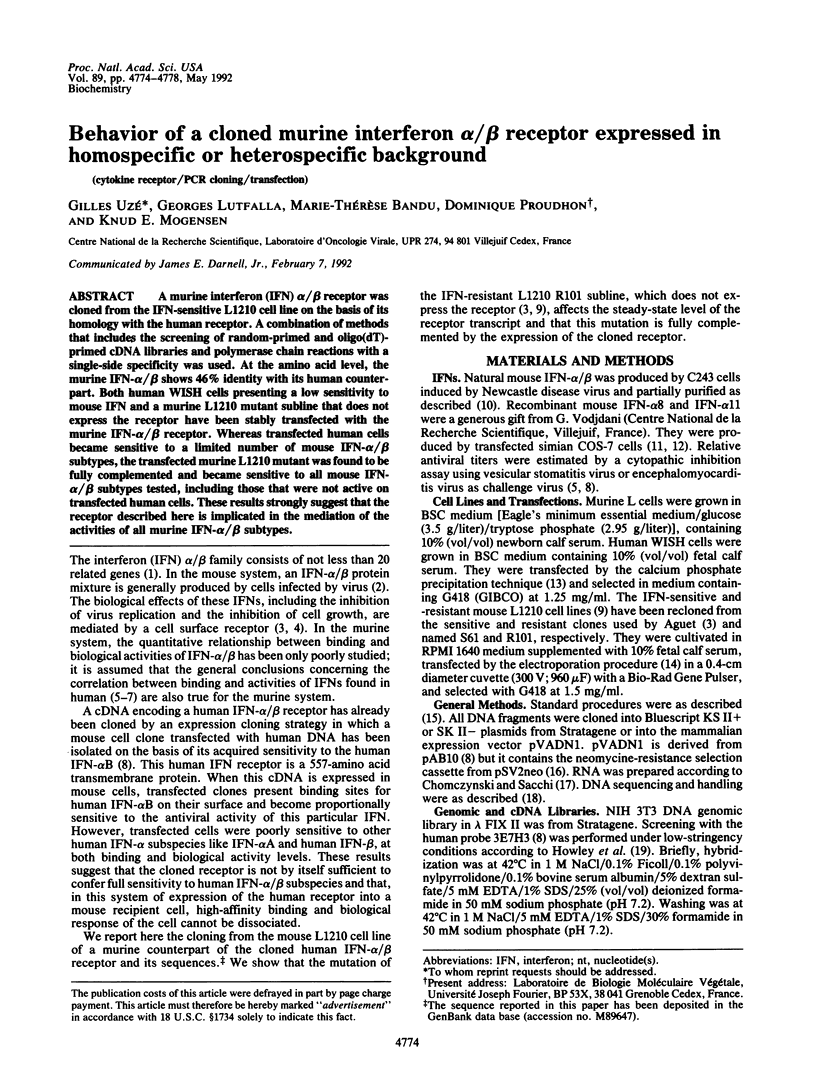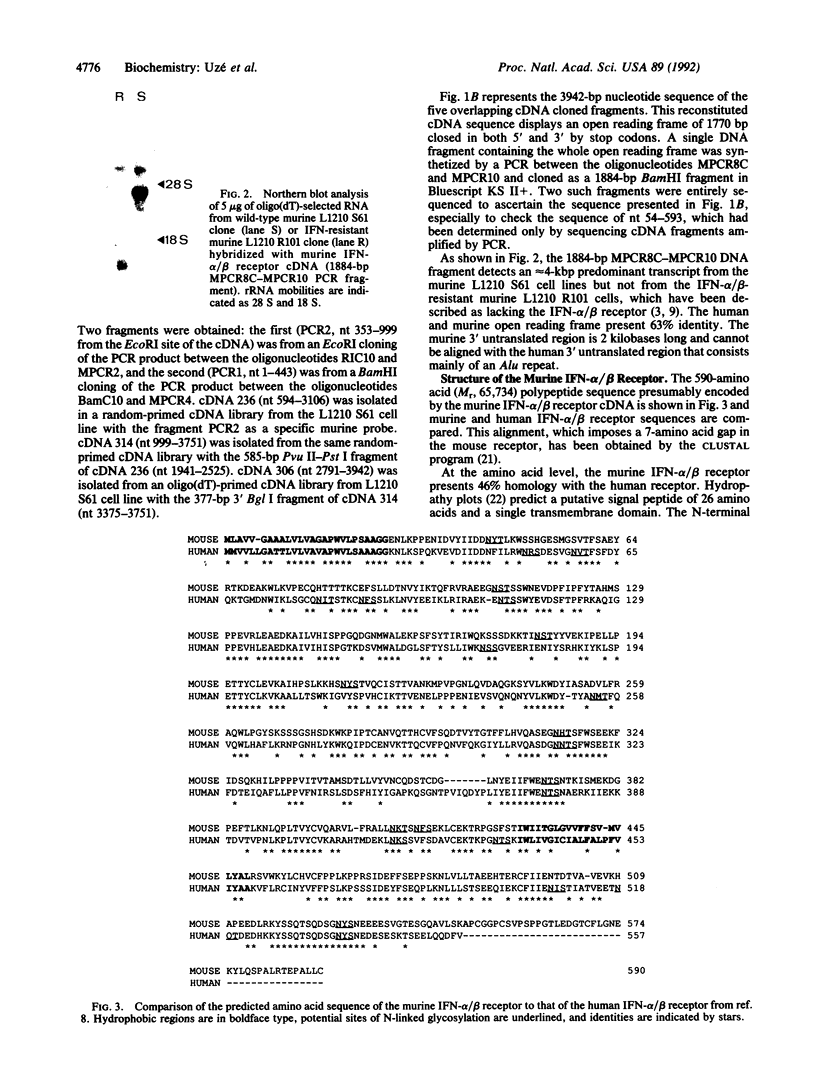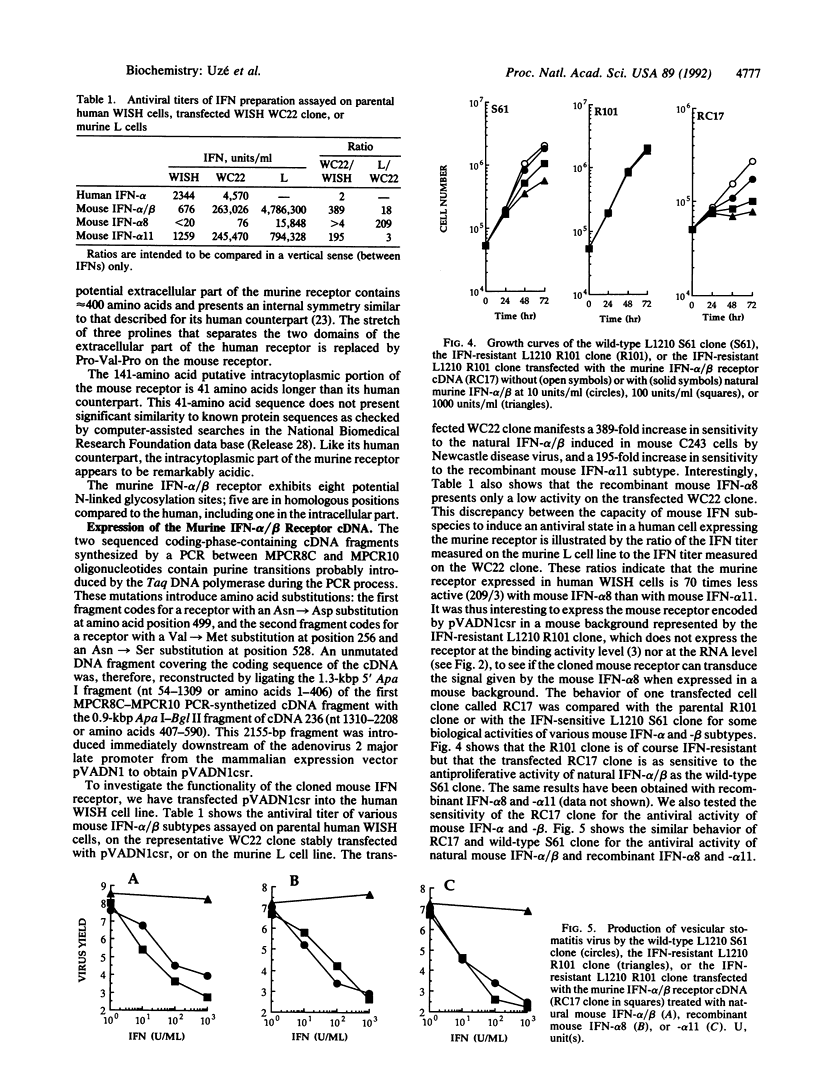Abstract
A murine interferon (IFN) alpha/beta receptor was cloned from the IFN-sensitive L1210 cell line on the basis of its homology with the human receptor. A combination of methods that includes the screening of random-primed and oligo(dT)-primed cDNA libraries and polymerase chain reactions with a single-side specificity was used. At the amino acid level, the murine IFN-alpha/beta shows 46% identity with its human counterpart. Both human WISH cells presenting a low sensitivity to mouse IFN and a murine L1210 mutant subline that does not express the receptor have been stably transfected with the murine IFN-alpha/beta receptor. Whereas transfected human cells became sensitive to a limited number of mouse IFN-alpha/beta subtypes, the transfected murine L1210 mutant was found to be fully complemented and became sensitive to all mouse IFN-alpha/beta subtypes tested, including those that were not active on transfected human cells. These results strongly suggest that the receptor described here is implicated in the mediation of the activities of all murine IFN-alpha/beta subtypes.
Full text
PDF




Images in this article
Selected References
These references are in PubMed. This may not be the complete list of references from this article.
- Aguet M., Blanchard B. High affinity binding of 125I-Labeled mouse interferon to a specific cell surface receptor. II. Analysis of binding properties. Virology. 1981 Dec;115(2):249–261. doi: 10.1016/0042-6822(81)90108-2. [DOI] [PubMed] [Google Scholar]
- Aguet M. High-affinity binding of 125I-labelled mouse interferon to a specific cell surface receptor. Nature. 1980 Apr 3;284(5755):459–461. doi: 10.1038/284459a0. [DOI] [PubMed] [Google Scholar]
- Bazan J. F. Structural design and molecular evolution of a cytokine receptor superfamily. Proc Natl Acad Sci U S A. 1990 Sep;87(18):6934–6938. doi: 10.1073/pnas.87.18.6934. [DOI] [PMC free article] [PubMed] [Google Scholar]
- Chomczynski P., Sacchi N. Single-step method of RNA isolation by acid guanidinium thiocyanate-phenol-chloroform extraction. Anal Biochem. 1987 Apr;162(1):156–159. doi: 10.1006/abio.1987.9999. [DOI] [PubMed] [Google Scholar]
- Chu G., Hayakawa H., Berg P. Electroporation for the efficient transfection of mammalian cells with DNA. Nucleic Acids Res. 1987 Feb 11;15(3):1311–1326. doi: 10.1093/nar/15.3.1311. [DOI] [PMC free article] [PubMed] [Google Scholar]
- Church G. M., Gilbert W. Genomic sequencing. Proc Natl Acad Sci U S A. 1984 Apr;81(7):1991–1995. doi: 10.1073/pnas.81.7.1991. [DOI] [PMC free article] [PubMed] [Google Scholar]
- Coulombel C., Vodjdani G., Doly J. Isolation and characterization of a novel interferon-alpha-encoding gene, IFN-alpha 11, within a murine IFN cluster. Gene. 1991 Aug 15;104(2):187–195. doi: 10.1016/0378-1119(91)90249-b. [DOI] [PubMed] [Google Scholar]
- Eid P., Bandu M. T., Uze G., Mogensen K. E. Interferon removes its own receptors as it blocks the division of Daudi cells. Eur J Biochem. 1988 Feb 1;171(3):675–682. doi: 10.1111/j.1432-1033.1988.tb13839.x. [DOI] [PubMed] [Google Scholar]
- Graham F. L., van der Eb A. J. A new technique for the assay of infectivity of human adenovirus 5 DNA. Virology. 1973 Apr;52(2):456–467. doi: 10.1016/0042-6822(73)90341-3. [DOI] [PubMed] [Google Scholar]
- Gresser I., Bandu M. T., Brouty-Boyé D. Interferon and cell division. IX. Interferon-resistant L1210 cells: characteristics and origin. J Natl Cancer Inst. 1974 Feb;52(2):553–559. doi: 10.1093/jnci/52.2.553. [DOI] [PubMed] [Google Scholar]
- Higgins D. G., Sharp P. M. CLUSTAL: a package for performing multiple sequence alignment on a microcomputer. Gene. 1988 Dec 15;73(1):237–244. doi: 10.1016/0378-1119(88)90330-7. [DOI] [PubMed] [Google Scholar]
- Howley P. M., Israel M. A., Law M. F., Martin M. A. A rapid method for detecting and mapping homology between heterologous DNAs. Evaluation of polyomavirus genomes. J Biol Chem. 1979 Jun 10;254(11):4876–4883. [PubMed] [Google Scholar]
- Kawade Y., Aguet M., Tovey M. G. Antigenic correlations between components of C243 and L cell interferons. Antiviral Res. 1982 Aug;2(3):155–159. doi: 10.1016/0166-3542(82)90017-1. [DOI] [PubMed] [Google Scholar]
- Kyte J., Doolittle R. F. A simple method for displaying the hydropathic character of a protein. J Mol Biol. 1982 May 5;157(1):105–132. doi: 10.1016/0022-2836(82)90515-0. [DOI] [PubMed] [Google Scholar]
- Lutfalla G., Gardiner K., Proudhon D., Vielh E., Uzé G. The structure of the human interferon alpha/beta receptor gene. J Biol Chem. 1992 Feb 5;267(4):2802–2809. [PubMed] [Google Scholar]
- Mogensen K. E., Bandu M. T. Kinetic evidence for an activation step following binding of human interferon alpha 2 to the membrane receptors of Daudi cells. Eur J Biochem. 1983 Aug 1;134(2):355–364. doi: 10.1111/j.1432-1033.1983.tb07575.x. [DOI] [PubMed] [Google Scholar]
- Mogensen K. E., Uzé G., Eid P. The cellular receptor of the alpha-beta interferons. Experientia. 1989 Jun 15;45(6):500–508. doi: 10.1007/BF01990498. [DOI] [PubMed] [Google Scholar]
- Navarro S., Dion M., Vodjdani G., Berlot-Picard F., Doly J. Isolation and characterization of a functional murine interferon alpha gene which is not expressed in fibroblasts upon virus induction. J Gen Virol. 1989 Jun;70(Pt 6):1381–1389. doi: 10.1099/0022-1317-70-6-1381. [DOI] [PubMed] [Google Scholar]
- Nicola N. A., Metcalf D. Subunit promiscuity among hemopoietic growth factor receptors. Cell. 1991 Oct 4;67(1):1–4. doi: 10.1016/0092-8674(91)90564-f. [DOI] [PubMed] [Google Scholar]
- Southern P. J., Berg P. Transformation of mammalian cells to antibiotic resistance with a bacterial gene under control of the SV40 early region promoter. J Mol Appl Genet. 1982;1(4):327–341. [PubMed] [Google Scholar]
- Thoreau E., Petridou B., Kelly P. A., Djiane J., Mornon J. P. Structural symmetry of the extracellular domain of the cytokine/growth hormone/prolactin receptor family and interferon receptors revealed by hydrophobic cluster analysis. FEBS Lett. 1991 Apr 22;282(1):26–31. doi: 10.1016/0014-5793(91)80437-8. [DOI] [PubMed] [Google Scholar]
- Tovey M. G., Begon-Lours J., Gresser I. A method for the large scale production of potent interferon preparations. Proc Soc Exp Biol Med. 1974 Jul;146(3):809–815. doi: 10.3181/00379727-146-38196. [DOI] [PubMed] [Google Scholar]
- Uzé G., Lutfalla G., Eid P., Maury C., Bandu M. T., Gresser I., Mogensen K. Murine tumor cells expressing the gene for the human interferon alpha beta receptor elicit antibodies in syngeneic mice to the active form of the receptor. Eur J Immunol. 1991 Feb;21(2):447–451. doi: 10.1002/eji.1830210229. [DOI] [PubMed] [Google Scholar]
- Uzé G., Lutfalla G., Gresser I. Genetic transfer of a functional human interferon alpha receptor into mouse cells: cloning and expression of its cDNA. Cell. 1990 Jan 26;60(2):225–234. doi: 10.1016/0092-8674(90)90738-z. [DOI] [PubMed] [Google Scholar]
- Uzé G., Mogensen K. E., Aguet M. Receptor dynamics of closely related ligands: "fast' and "slow' interferons. EMBO J. 1985 Jan;4(1):65–70. doi: 10.1002/j.1460-2075.1985.tb02318.x. [DOI] [PMC free article] [PubMed] [Google Scholar]
- Vanden Broecke C., Tovey M. G. Expression of the genes of class I interferons and interleukin-6 in individual cells. J Interferon Res. 1991 Apr;11(2):91–103. [PubMed] [Google Scholar]
- Weissmann C., Weber H. The interferon genes. Prog Nucleic Acid Res Mol Biol. 1986;33:251–300. doi: 10.1016/s0079-6603(08)60026-4. [DOI] [PubMed] [Google Scholar]



